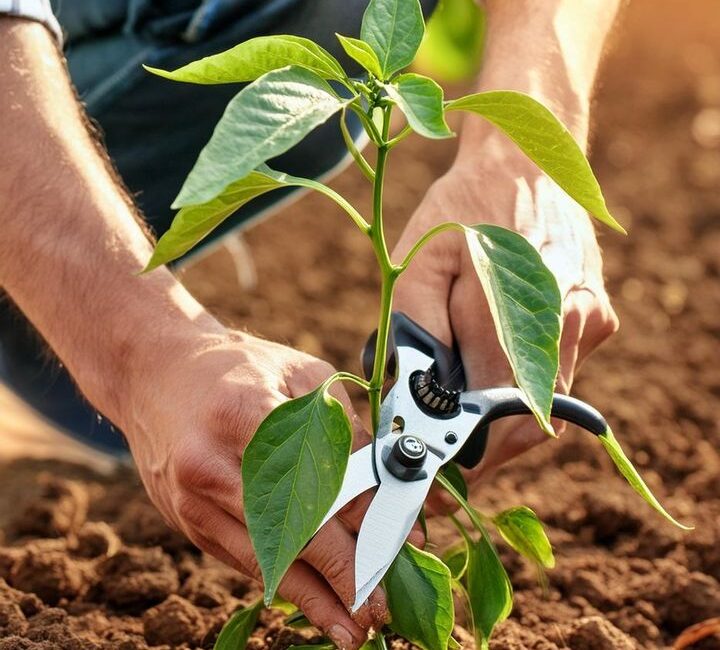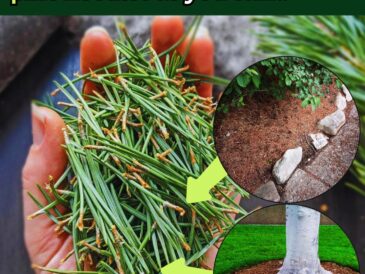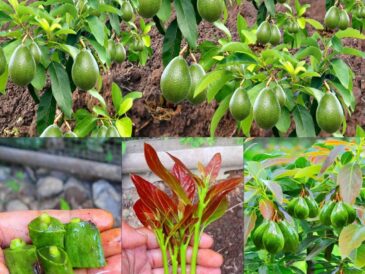3. Techniques for Pruning Pepper Plants
There are different techniques for pruning pepper plants, depending on the goal you want to achieve. Let’s take a closer look at the best methods for pruning peppers at various stages of growth.
1. Pinching the Top (Early Growth Stage)
One of the most effective ways to encourage a bushier, stronger pepper plant is by pinching the top of the main stem. When your pepper plant reaches around 6 to 8 inches tall and has a few sets of leaves, pinch off the very tip of the main stem. This action encourages the plant to branch out and form lateral stems, which will eventually lead to more flowers and fruit.
How to Pinch the Top:
- Use your fingers or a clean pair of pruning shears to snip off the top 1-2 inches of the plant’s main stem.
- Be careful not to damage the surrounding leaves or stems.
- Pinching the top encourages the plant to send out multiple side branches, resulting in a fuller, more productive plant.
2. Removing Suckers (Mid-Growth Stage)
As your pepper plant continues to grow, it will produce additional shoots, called suckers, in the spaces between the main stem and the branches. While some suckers may eventually produce fruit, many of them are small and weak. Removing these suckers allows the plant to focus its energy on the stronger, more productive branches.
How to Remove Suckers:
- Identify the small shoots growing at the junctions of the main stem and side branches.
- Use clean pruning shears to carefully trim them back.
- Removing suckers ensures that the plant’s energy is directed toward the production of larger, more robust fruit.
3. Thinning and Shaping (Mid to Late Growth Stage)
During the mid to late growth stages, it’s important to thin out the plant to prevent overcrowding and ensure adequate airflow. Thin out any stems that are growing inward or crossing each other. This helps to open up the plant, allowing sunlight to penetrate all parts of the plant and reduces the risk of disease.
How to Thin and Shape:
- Look for branches that are growing inwards or are too close together.
- Remove any branches that are weak or damaged.
- Trim away any unnecessary growth, but be sure to leave the main stems intact to support the fruit.
4. Cutting Back Dead or Diseased Foliage (Late-Season Pruning)
At the end of the growing season, it’s important to clean up the plant to prevent pests and diseases from taking hold. Remove any dead or yellowing leaves, as they may harbor insects or fungi. This final round of pruning helps keep the plant healthy and prepares it for the cooler months.
How to Clean Up the Plant:
- Carefully remove any yellowing or dead leaves and stems.
- Dispose of the cuttings in a compost bin or trash to avoid spreading disease.
- Make sure to leave any healthy leaves and branches intact to maintain the plant’s overall health.
4. Tips for Maximizing Pepper Plant Health and Yield
Pruning is a key step in ensuring the best harvest, but there are other practices you can follow to promote pepper plant health and productivity. Here are some additional tips:
- Provide Adequate Water: Peppers need consistent moisture, especially during the fruiting stage. Be sure to water deeply and evenly to avoid stress on the plant.
- Fertilize Regularly: Use a balanced fertilizer or compost to ensure your pepper plants have all the nutrients they need for healthy growth.
- Use Mulch: Applying mulch around the base of your pepper plants helps retain moisture, suppress weeds, and regulate soil temperature.
- Support Your Plants: As your pepper plants grow taller and start to produce fruit, it’s important to provide support to prevent the branches from breaking. Use stakes or cages to keep the plants upright and encourage healthy growth.
- Protect Against Pests: Keep an eye on your pepper plants for signs of pests such as aphids, whiteflies, or spider mites. Use organic pest control methods to protect your plants without harming beneficial insects.
Conclusion
Pruning is undeniably one of the most important steps you can take to ensure a thriving pepper plant. By removing unnecessary growth, encouraging a strong structure, and redirecting energy into fruit production, pruning helps to create the perfect conditions for a bountiful harvest. Whether you’re a novice gardener or an experienced grower, mastering the art of pruning will help you produce the ultimate pepper harvest with robust, flavorful peppers.




